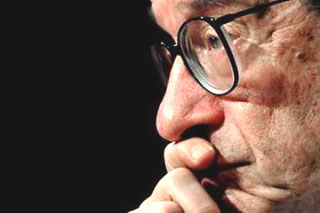|
US Fed raises rates for third time
(Agencies)
Updated: 2004-09-22 07:49
The U.S. Federal Reserve on Tuesday raised interest rates for the third time
this year by a quarter of a percentage point and said the economy was regaining
momentum, signaling at least one more to come.

The U.S. Federal
Reserve raised interest rates on September 21, 2004 by a quarter
percentage point as expected, the third straight rise in a bid to keep a
lid on inflation pressures despite some signs of economic softness. The
unanimous decision by the policy-setting Federal Open Market Committee
moves the benchmark federal funds rate -- which influences credit costs
throughout the economy -- to 1.75 percent. The Fed lifted rates by
matching amounts in June and at its last policy session on Aug. 10,
spelling an end to a lengthy period of super-low rates. Fed Chairman Alan
Greenspan is seen in this April 21 file photo. [Reuters]
| The widely expected and unanimous decision by the
policy-setting Federal Open Market Committee moves the benchmark federal funds
rate -- which influences credit costs throughout the economy -- to 1.75 percent
from 1.5 percent.
The central bank lifted short-term rates by matching amounts at its policy
sessions in June and on Aug. 10, ending a long period of super-low borrowing
costs.
Many economists expect a fourth rise at the next meeting on Nov. 10, about a
week after the U.S. presidential elections.
"After moderating earlier this year partly in response to the substantial
rise in energy prices, output growth appears to have regained some traction, and
labor market conditions have improved modestly," the Fed said in a statement
outlining its decision, which also increased the largely symbolic discount rate
to 2.75 percent.

A one dollar chrome
printing plate. The dollar traded mostly lower, failing to get a lift from
a Federal Reserve quarter-point rate hike that had been widely
expected and priced into the
market.[AFP/file] | The Fed also said inflation pressures and expectations had eased despite a
rise in energy costs.
It said risks to the U.S. economy remained balanced between weaker growth and
higher prices and repeated a pledge to undertake a "measured" course of rate
increases.
KEEPING OPTIONS OPEN
Analysts said the Fed, with its carefully couched language, seemed to be
keeping its options open on whether to steadily ratchet rates up or take a pause
if economic data weaken.
"This is a story that's being written as the economy goes along as far as how
fast the Fed will raise rates," said economist William Hornbarger of A.G.
Edwards and Sons Inc. in St. Louis, Mo. "They've indicated they will keep
raising rates; the question is how quickly."
A Reuters poll of 22 top Wall Street bond dealers found all agreed the Fed
would boost interest rates a further quarter percentage point in November.
At that point, 15 dealers think the Fed will hold at 2 percent through the
end of the year while seven predicted another quarter percentage point hike at
the eighth and final policy-setting session on Dec. 14.
The picture was muddier for next year, with bond dealers estimating the fed
funds rate could be anywhere between 2 percent and 4.5 percent when 2005 ends --
reflecting widely divergent opinions about growth prospects and inflation risks.
One concern this year is that a soft pace of job creation and higher energy
prices have put strain on consumers, who were the main support for a teetering
U.S. economy in the slow recovery from the 2001 recession. Retail sales fell in
August.
Some economists believe the softness may persist and that the rate-rise cycle
is near an end. However, the Fed insists the economy is getting its footing
after a "soft patch" that began mid-year.
Financial markets were unsure how to interpret the Fed's statement. Some saw
it as a signal that several more rate rises lay ahead but others took it as
reassurance that the path to higher rates would be gradual.
Short-term Treasury debt prices weakened as participants saw a higher
likelihood of a hike in November, but long-term bond prices gained on Fed
assurances that inflation was subdued -- language unlikely to presage aggressive
rate increases.
Stock prices strengthened, buoyed by the reference to output growth regaining
traction -- words Fed Chairman Alan Greenspan offered to Congress earlier this
month.
The Dow Jones industrial average closed up 40.04 points, or 0.39
percent, at 10,244.93. The technology-laced Nasdaq Composite Index finished up
13.11 points, or 0.69 percent, at 1,921.18.
This was the final policy meeting before the Nov. 2 presidential vote.
Democratic and Republican campaigns have presented starkly contrasting views
of the economy's health.
President Bush says his administration's tax cuts lifted the United States
out of economic doldrums that began before he came to power in 2001.
Democratic presidential contender Sen. John Kerry says Bush's policies
have failed to spur hiring and have fueled record budget deficits that imperil
the future.
The Bush administration's top economic official, Treasury Secretary John
Snow, was unfazed by the Fed's decision, telling reporters: "Increases in
discount rates are consistent with a recovering economy."
The Fed has been trying to bring official interest rates to a level seen as
normal or "neutral" -- one that neither hinders expansion nor spurs it enough to
trigger inflation pressure. Exactly where that lies remains open to debate.
Private-sector economists argue a neutral rate could be around 3 percent but
Greenspan has said only that the Fed won't know where the right level lies
"until we get there."
| |
 |
|
 |
|
|
Today's
Top News |
|
|
|
Top World
News |
 |
|
 |
|
|
|
|
|
|


